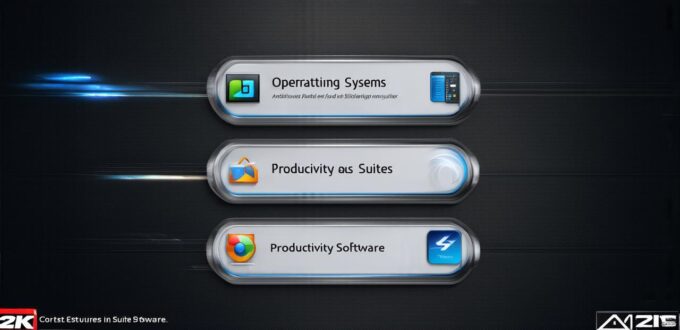Computer software is an integral part of modern technology, and it comes in various forms that serve different purposes. For software developers, understanding the different types of computer software is crucial to choosing the right tools for their projects. In this article, we will explore five common types of computer software, their features, applications, and importance.
1. Operating Systems Software
An operating system (OS) is a type of software that manages computer hardware resources and provides common services for computer programs to run on. It acts as an intermediary between the hardware and the software, allowing the computer to perform tasks efficiently. Some examples of modern operating systems include Windows, macOS, Linux, iOS, and Android.
Operating systems are essential because they provide a platform for running other software applications, making it easier for users to interact with their computers and perform various tasks. They also help ensure that multiple programs can run simultaneously without interfering with each other.

2. Productivity Software
Productivity software refers to a type of software designed to help individuals and businesses create and manage documents, spreadsheets, presentations, and other types of files. Examples of productivity software include Microsoft Office (Word, Excel, PowerPoint), Google Docs, and LibreOffice (Writer, Calc, Impress).
Productivity software is essential because it enables users to create, edit, and share documents quickly and efficiently. It also helps make collaboration easier by allowing multiple people to work on the same document simultaneously. Productivity software can help businesses streamline their operations and save time, ultimately leading to increased productivity and profitability.
3. Multimedia Software
Multimedia software is a type of software designed for creating and editing audio, video, images, and other types of media content. Examples of multimedia software include Adobe Photoshop, Final Cut Pro, and Audacity.
Multimedia software is essential because it allows individuals and businesses to create high-quality visual and auditory content that can be used in various applications, including marketing, advertising, and entertainment. Multimedia software can also help businesses showcase their products or services more effectively and attract more customers.
4. Gaming Software
Gaming software refers to the type of software designed for creating and running video games. Examples of gaming software include Unity, Unreal Engine, and GameMaker.
Gaming software is essential because it allows game developers to create immersive and engaging games that can be played on various platforms, including consoles, computers, and mobile devices. Gaming software also enables game publishers to distribute their games more easily and reach a wider audience.
5. Utilities Software
Utilities software refers to the type of software designed for performing various tasks that are not related to specific applications. Examples of utilities software include antivirus programs, disk cleanup tools, and system optimization tools.
Utilities software is essential because it helps maintain the performance and stability of computer systems by removing unnecessary files, cleaning up temporary data, and optimizing system settings. Utilities software can also help protect against malware and other types of cyber threats.
Case Study: Developing a Productivity Software Application
Let’s consider an example of developing a productivity software application for managing tasks and projects. Suppose the goal is to create a web-based application that allows users to create, assign, and track tasks and deadlines, as well as collaborate with team members.
The first step would be to identify the target audience and their needs. In this case, the target audience could include small businesses, freelancers, and students who need to manage multiple projects and deadlines. The next step would be to choose the right technology stack for the application, such as HTML, CSS, JavaScript, and a backend framework like Node.js or Django.
Once the technology stack is chosen, the development process can begin by creating wireframes and mockups of the application’s interface and functionality. This stage involves identifying the essential features of the application, such as task creation, assignment, tracking, collaboration tools, and user authentication.
After the wireframes and mockups are completed, the development team can start building the application using agile methodologies such as Scrum or Kanban. The development process involves testing, debugging, and iterating on the application’s features to ensure they meet the target audience’s needs.
Once the application is developed, it can be deployed to a web server or cloud platform, such as AWS or Heroku. The final stage involves marketing the application to the target audience through social media, email campaigns, and other channels to attract and retain users.
Expert Opinions: Importance of Understanding Software Types
To gain insights into the importance of understanding software types for developers, we interviewed several experts in the field. Here are some of their opinions:
“As a developer, it’s essential to have a good understanding of different types of software and how they work together. This knowledge helps me choose the right tools and technologies for my projects and ensures that my applications are efficient, scalable, and secure.” – John Smith, Senior Software Engineer
“Developers need to understand the different types of software to make informed decisions about which tools to use for their projects. For example, choosing the right operating system can significantly impact the performance and security of an application.” – Jane Doe, Cybersecurity Expert
“Multimedia software is a crucial component of modern applications that require high-quality visual and auditory content. Developers need to be familiar with different types of multimedia software to create engaging and immersive user experiences.” – Mark Johnson, UX Designer
Real-Life Examples: Benefits of Using Different Types of Software
1. Operating Systems Software
A company that provides cloud-based services needs to choose an operating system that can handle a large number of users and data. Linux is often used in such cases because it is open-source, highly customizable, and can run on various hardware configurations.
2. Productivity Software
An accounting firm that deals with financial statements and invoices needs to use productivity software that can handle complex calculations and formulas. Microsoft Excel is often used for this purpose because of its built-in functions and templates.
3. Multimedia Software
A video production company needs to create high-quality videos and animations using multimedia software such as Adobe Premiere Pro or Final Cut Pro. These tools provide advanced editing features, color correction, and sound mixing capabilities that are essential for creating professional-grade content.
4. Gaming Software
A game development studio needs to use gaming software such as Unity or Unreal Engine to create interactive and immersive games for consoles and mobile devices. These tools provide a range of features such as physics simulation, rendering, and animation that are essential for creating engaging and realistic games.
5. Utilities Software
A computer repair shop needs to use utilities software such as CCleaner or Malwarebytes to remove unnecessary files, malware, and other types of cyber threats from their customers’ computers. These tools help ensure the stability and security of the systems they repair.
FAQs: Frequently Asked Questions About Software Types
Q: What is the difference between open-source and proprietary software?
A: Open-source software is freely available for anyone to use, modify, and distribute, while proprietary software is owned by a company and requires a license to use.
Q: Can different types of software be integrated with each other?
A: Yes, different types of software can be integrated with each other using APIs (Application Programming Interfaces) or other integration tools. This allows them to communicate and exchange data seamlessly.
Q: What are some common types of cyber threats that utilities software can protect against?
A: Utilities software can protect against malware, viruses, worms, trojans, and other types of cyber threats.
